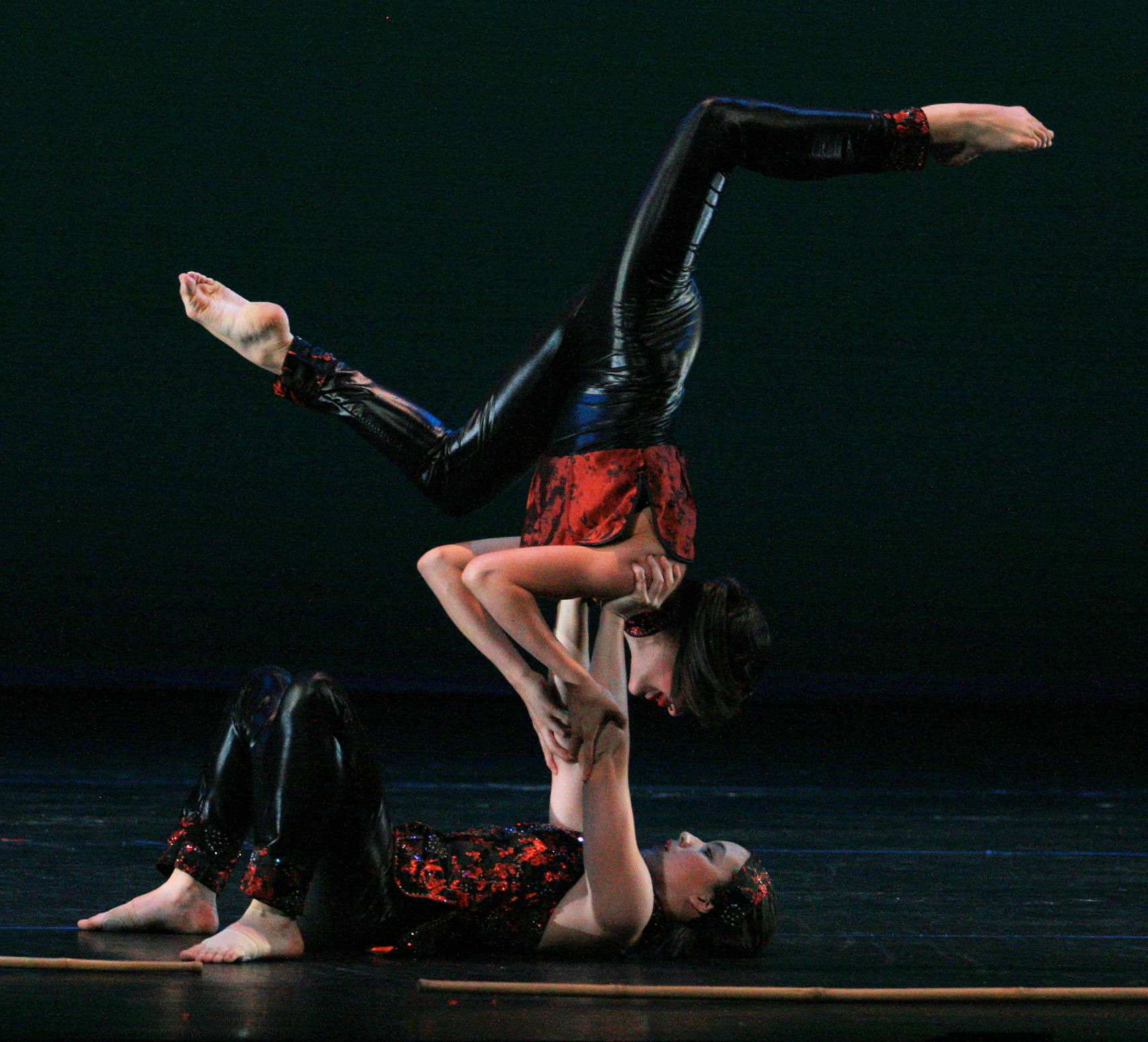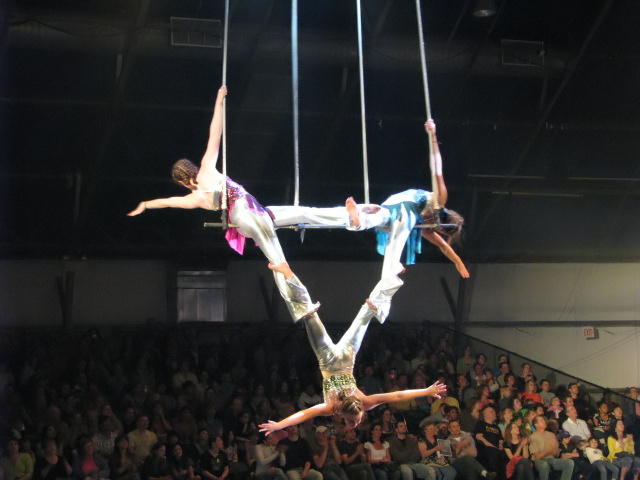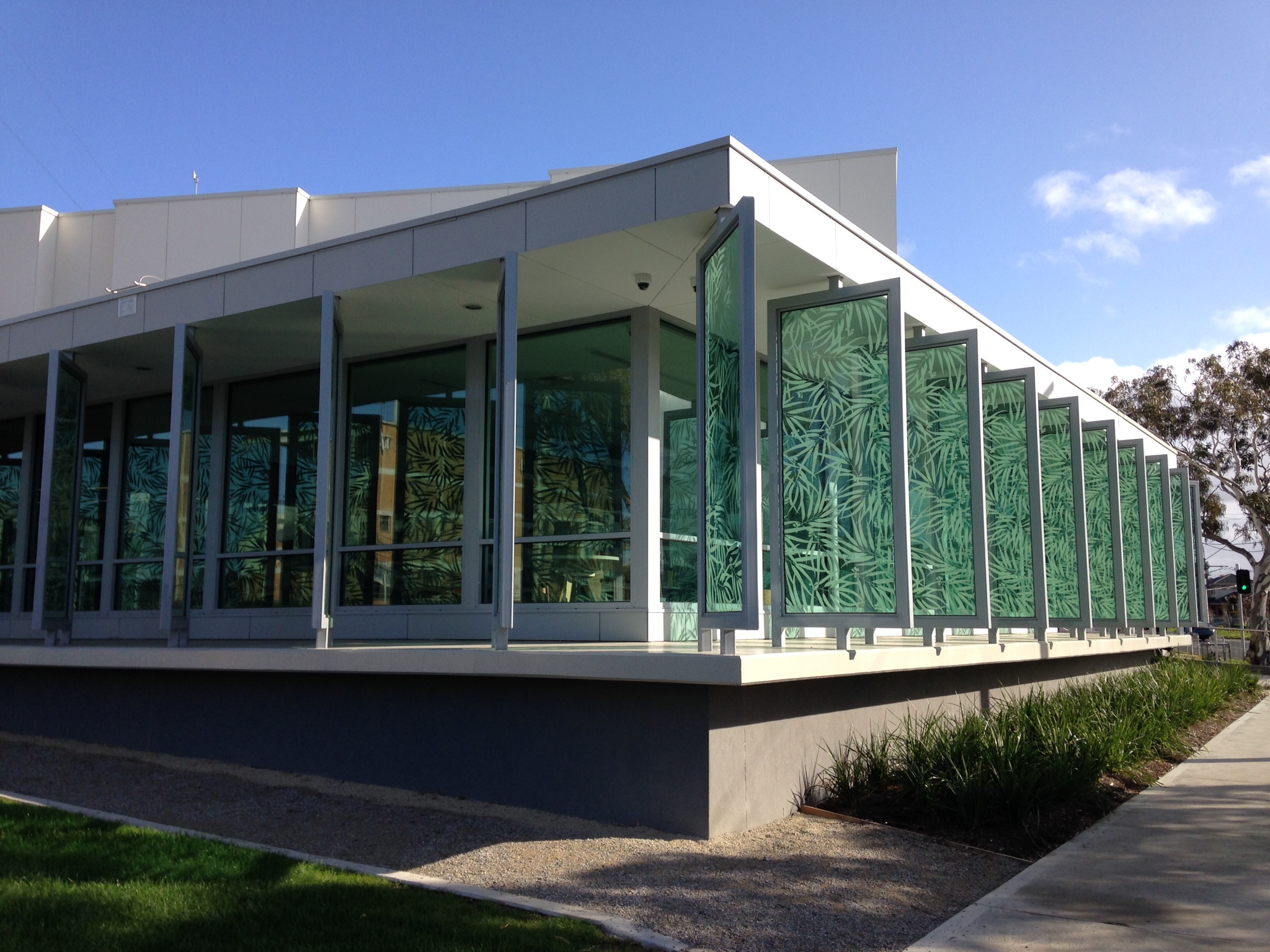|
Women's Circus (Melbourne)
The Women's Circus, a feminist not for profit organisation, provides circus performance training and social arts projects for women, trans and non binary people in the western region of Melbourne, Victoria, Australia. Training programs focus on the physical and imaginative potential of the human body, self-awareness and self-esteem. It has a history of original productions with social, educational and health themes related to women's lives. History The circus began in 1991, as an initiative of the Footscray Community Arts Centre, offering training and performance projects. Women recognised as founders include Donna Jackson, director; Sally Forth, trainer and Elizabeth Walsh, director of the Footscray Community Arts Centre. The inspiration was built on the work of an earlier Wimmin's Circus, Australia's first women's circus established in Melbourne which ran from 1978-1981. The Wimmin's Circus was supported in its early days by access to the facilities and expertise of CircusOz. ... [...More Info...] [...Related Items...] OR: [Wikipedia] [Google] [Baidu] |
Feminism
Feminism is a range of socio-political movements and ideologies that aim to define and establish the political, economic, personal, and social equality of the sexes. Feminism incorporates the position that society prioritizes the male point of view and that women are treated unjustly in these societies. Efforts to change this include fighting against gender stereotypes and improving educational, professional, and interpersonal opportunities and outcomes for women. Feminist movements have campaigned and continue to campaign for women's rights, including the right to vote, run for public office, work, earn equal pay, own property, receive education, enter contracts, have equal rights within marriage, and maternity leave. Feminists have also worked to ensure access to contraception, legal abortions, and social integration and to protect women and girls from rape, sexual harassment, and domestic violence. Changes in female dress standards and acceptable physical act ... [...More Info...] [...Related Items...] OR: [Wikipedia] [Google] [Baidu] |
Hula Hoop
A hula hoop is a toy hoop that is twirled around the waist, limbs or neck. It can also be wheeled along the ground like a wheel, with careful execution. They have been used by children and adults since at least 500 BC. The modern hula hoop was inspired by Australian bamboo hoops. Common lore posits the creators of the plastic hoop popularised in the US witnessed Australian children playing with bamboo hoops while driving past in an automobile. The new plastic version was popularized in 1958 by the Wham-O toy company and became a fad. Hula hoops for children generally measure approximately in diameter, while those for adults measure around . Traditional materials for hoops include willow, rattan (a flexible and strong vine), grapevines and stiff grasses. Commercial hoops are usually made of plastic tubing. Origins Native American Hoop Dance is a form of storytelling dance incorporating hoops as props. These props are used to create both static and dynamic shapes, which re ... [...More Info...] [...Related Items...] OR: [Wikipedia] [Google] [Baidu] |
Circus Schools
A circus is a company of performers who put on diverse entertainment shows that may include clowns, acrobats, trained animals, trapeze acts, musicians, dancers, hoopers, tightrope walkers, jugglers, magicians, ventriloquists, and unicyclists as well as other object manipulation and stunt-oriented artists. The term ''circus'' also describes the performance which has followed various formats through its 250-year modern history. Although not the inventor of the medium, Philip Astley is credited as the father of the modern circus. In 1768, Astley, a skilled equestrian, began performing exhibitions of trick horse riding in an open field called Ha'Penny Hatch on the south side of the Thames River, England. In 1770, he hired acrobats, tightrope walkers, jugglers and a clown to fill in the pauses between the equestrian demonstrations and thus chanced on the format which was later named a "circus". Performances developed significantly over the next fifty years, with large-scale ... [...More Info...] [...Related Items...] OR: [Wikipedia] [Google] [Baidu] |
Australian Circuses
Australian(s) may refer to: Australia * Australia, a country * Australians, citizens of the Commonwealth of Australia ** European Australians ** Anglo-Celtic Australians, Australians descended principally from British colonists ** Aboriginal Australians, indigenous peoples of Australia as identified and defined within Australian law * Australia (continent) ** Indigenous Australians * Australian English, the dialect of the English language spoken in Australia * Australian Aboriginal languages * ''The Australian ''The Australian'', with its Saturday edition, ''The Weekend Australian'', is a broadsheet newspaper published by News Corp Australia since 14 July 1964.Bruns, Axel. "3.1. The active audience: Transforming journalism from gatekeeping to gatew ...'', a newspaper * Australiana, things of Australian origins Other uses * Australian (horse), a racehorse * Australian, British Columbia, an unincorporated community in Canada See also * The Australian (disambiguation ... [...More Info...] [...Related Items...] OR: [Wikipedia] [Google] [Baidu] |
List Of Circuses And Circus Owners
There have been many famous modern circuses since the first modern circus was staged by Philip Astley in London on January 9, 1768. Many are best known by the name of their principal owner. The following is a list of both circuses and their country of origin. For more information on circuses in general see Circus, or Contemporary circus, or for information regarding the ancient Roman circus, see Circus Maximus. List See also *History of Indian circus Although street performances similar to circuses have existed in India since ancient times, a circus similar to the one described by Philip Astley, known as the father of the modern circus, as described in 1770, only existed in India in the 1880s. ... References {{DEFAULTSORT:Circuses and circus owners Entertainment lists ... [...More Info...] [...Related Items...] OR: [Wikipedia] [Google] [Baidu] |
Tumbling (gymnastics)
Tumbling, sometimes referred to as power tumbling, is a gymnastics discipline in which participants perform a series of acrobatic skills down a long sprung track. Each series, known as a pass, comprises eight elements in which the athlete jumps, twists and flips placing only their hands and feet on the track. Tumblers are judged on the difficulty and form of their routine. There are both individual and team competitions in the sport. ''Tumbling'' can also refer more generally to similar acrobatic skills performed on their own or in other gymnastics events, such as in floor exercises or on the balance beam. Tumbling is governed by the FIG, the International Federation of Gymnastics, and is included as an event within trampoline gymnastics. Although tumbling is not currently an Olympic event, elite tumblers competing at the international level can compete in various events organised by the FIG, continental confederations as well as at the European Games and World Games. Histor ... [...More Info...] [...Related Items...] OR: [Wikipedia] [Google] [Baidu] |
Acrobalance
Acrobalance is a floor-based acrobatic art that involves balances, lifts and creating shapes performed in pairs or groups. A performer on the ground doing the lifting and supporting in an acrobalance formation is often called the ''base'', while a performer being lifted or tossed can be referred to as the ''flyer'' (or ''flier''). Formats include male/female duo, trio, female/female, and other variations. Acrobalance acts require a high degree of care, coordination, proprioceptive awareness, and mutual trust from the performers in order to avoid injury; they are often set to music and performed as part of circuses. Acrobalance performances can now also be seen on a wide variety of shows such as street performances, incorporated into children's theater and as part of modern dance performances. Technique Acrobalance is the combination of the two athletic art forms: * '' Adagio'': consists of partner lifts, usually performed by a man and a woman, where the male lifts his female pa ... [...More Info...] [...Related Items...] OR: [Wikipedia] [Google] [Baidu] |
Trapeze
A trapeze is a short horizontal bar hung by ropes or metal straps from a ceiling support. It is an aerial apparatus commonly found in circus performances. Trapeze acts may be static, spinning (rigged from a single point), swinging or flying, and may be performed solo, double, triple or as a group act. The name of the apparatus reflects the trapezoid shape made by the horizontal bar, ropes and ceiling support. History The art of trapeze performance is reported to have been developed by Jules Léotard, a young French acrobat and aerialist, in Toulouse in the mid-1800s. He is said to have used his father's swimming pool to practice. However, the name "trapeze" can be found in books dating as far back as twenty years earlier, before Léotard was born. One such example is George Roland’s “An Introductory Course of Modern Gymnastic Exercises”, published in 1832. Roland proposes the idea that the trapeze might owe its origin to Colonel Amoros, but ultimately deems the questio ... [...More Info...] [...Related Items...] OR: [Wikipedia] [Google] [Baidu] |
Juggling
Juggling is a physical skill, performed by a juggler, involving the manipulation of objects for recreation, entertainment, art or sport. The most recognizable form of juggling is toss juggling. Juggling can be the manipulation of one object or many objects at the same time, most often using one or two hands but also possible with feet. Jugglers often refer to the objects they juggle as ''props''. The most common props are balls, clubs, or rings. Some jugglers use more dramatic objects such as knives, fire torches or chainsaws. The term ''juggling'' can also commonly refer to other prop-based manipulation skills, such as diabolo, plate spinning, devil sticks, poi, cigar boxes, contact juggling, hooping, yo-yo, and hat manipulation. Etymology The words ''juggling'' and ''juggler'' derive from the Middle English ''jogelen'' ("to entertain by performing tricks"), which in turn is from the Old French '' jangler''. There is also the Late Latin form ''joculare'' of Latin ' ... [...More Info...] [...Related Items...] OR: [Wikipedia] [Google] [Baidu] |
City Of Maribyrnong
The City of Maribyrnong is a local government area within the metropolitan area of Melbourne, Australia. It comprises the inner western suburbs between 5 and 10 kilometres from Melbourne city centre. It was formed in 1994 from the merger of the City of Footscray and parts of the City of Sunshine. In June 2018, Maribyrnong had a population of 91,387. According to Local Government Victoria, Maribyrnong has the second most ethnically diverse population in Victoria, with 40% of residents born outside Australia. Many of Maribyrnong's former industrial sites have been replaced by residential developments. New residents are generally more educated and higher income. Maribyrnong attracted new cultural groups. Its name comes from the nearby Maribyrnong River. Wards and councillors Suburbs * Braybrook * Footscray * Kingsville * Maidstone * Maribyrnong * Seddon * Tottenham * West Footscray * Yarraville Community snapshot Figures below are drawn from the 2011 Census ... [...More Info...] [...Related Items...] OR: [Wikipedia] [Google] [Baidu] |
Circus
A circus is a company of performers who put on diverse entertainment shows that may include clowns, acrobats, trained animals, trapeze acts, musicians, dancers, hoopers, tightrope walkers, jugglers, magicians, ventriloquists, and unicyclists as well as other object manipulation and stunt-oriented artists. The term ''circus'' also describes the performance which has followed various formats through its 250-year modern history. Although not the inventor of the medium, Philip Astley is credited as the father of the modern circus. In 1768, Astley, a skilled equestrian, began performing exhibitions of trick horse riding in an open field called Ha'Penny Hatch on the south side of the Thames River, England. In 1770, he hired acrobats, tightrope walkers, jugglers and a clown to fill in the pauses between the equestrian demonstrations and thus chanced on the format which was later named a "circus". Performances developed significantly over the next fifty years, with large-scale theat ... [...More Info...] [...Related Items...] OR: [Wikipedia] [Google] [Baidu] |
Footscray, Victoria
Footscray is an inner-city suburb in Melbourne, Victoria, Australia, west of Melbourne's Central Business District, located within the City of Maribyrnong local government area. Footscray recorded a population of 17,131 at the . Footscray is characterised by a very diverse, multicultural central shopping area, which reflects the successive waves of immigration experienced by Melbourne, and by Footscray in particular. Once a centre for Greek, Italian and former Yugoslavian migrants, it later became a hub for Vietnamese and East African immigrants in Melbourne. It has recently begun to undergo rapid development and gentrification, and ''Time Out'' magazine placed Footscray at 13th in its '50 Coolest Neighbourhoods in the World' for 2019, reflecting its evolving reputation, citing in particular its diverse array of international cuisine, bars and nightlife, as well as its arts scene. Footscray is named after Foots Cray, on the River Cray in London, England. History Footscray ... [...More Info...] [...Related Items...] OR: [Wikipedia] [Google] [Baidu] |








